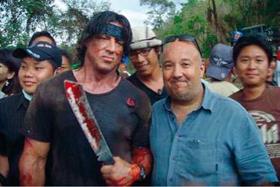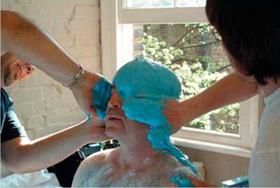Compared to making molds of inanimate objects, lifecasting can pose some potential safety hazards. Since the mold is made directly on an actor’s body, the materials must be safe and approved for use directly on the skin. There is also
the potential for injury if the subject is being lifecast in a standing position and faints from holding a stationary pose for too long. Feelings of claustrophobia and anxiety can also be a reaction for some actors enclosed in a mold, and it can seem to gain weight the longer it’s on the subject.
When lifecasting the face, you must take great care so that the actor can continue to breathe when a mold covers her mouth and nose; the nostrils must be kept clear but not with straws. There are two reasons not to use straws in a subject’s nose when making a lifecast: The straws change the shape of the nose, and even the very slightest of bumps will cause a rather good nosebleed. Don’t ask me how I know that. It’s always a good idea to ask your subject beforehand if she generally has trouble breathing out of both nostrils; if your subject is congested and stuffed up, she will need to take measures in advance of the lifecasting session that will allow her to breathe comfortably while the alginate is covering her face. It is also possible to do a lifecast with the mouth partly open.
While most alginates used for lifecasting are considered hypoallergenic— meaning that few people (if any) are allergic—in rare instances models can have allergic reactions to a material. But far from lifecasting being a negative experience, every model finds it interesting, and most models actually find the experience to be somewhat enjoyable, not unlike getting an extended—albeit unusual—facial. Some even fall asleep!
I’ve lost count of how many lifecasts I’ve done personally or supervised—quite a few— but I have never experienced an allergic reaction or had someone faint. I consider myself very fortunate. I have heard plenty of associates’ descriptions of subjects fainting. Fortunately most fainting spells are mild and brief, but they can still be awful. Not only can fainting create the very real possibility of cuts, bumps, and bruises on your subject, it can also result in vomiting; vomiting into a closed space is not good and will cause the subject to aspirate, or involuntarily inhale the vomit. That is really not good.
Other safety concerns to be aware of concern the lifecasting materials themselves—alginate, silicone, and plaster. The alginates used for lifecasting come as a very fine powder, and even when mixed very carefully with water they may create a substantial amount of dust. Many alginates also contain crystalline silica, which can cause silicosis—a disabling, nonreversible, and sometimes fatal lung disease caused by overexposure to respirable crystalline silica—so it is advisable to guard against breathing the dust while mixing your alginate.
Silicone that is safe for application directly to the skin, such as Smooth-On’s Body Double,® EnvironMolds’ LifeRite,® and Mould Life’s Life Form,® should only be used in a well-ventilated room; you should also do a small test on the back of your subject’s hand a day or so before to ensure that there is no allergic reaction. If you notice any type of skin reaction, do not use the product. When working with platinum silicone such as Body Double® LifeRite® and Life Form,® if you wear gloves you will want to wear vinyl or nitrile gloves, not latex gloves, as latex will inhibit if not completely prevent the cure of the silicone rubber. I’ll talk about silicone at greater length in a later chapter.
There are reasons you might want to use skin-safe platinum silicone for your lifecast instead of alginate, but there is a cost difference. Just to give an example of cost between the two materials, the amount of alginate needed to cast someone’s face and neck from the ears forward, across the top of the head, and down to the clavicles could cost $5.00-6.00 (£2.5-3.0); the same amount of skin-safe platinum-cure silicone can cost 10 times as much. Platinum is not cheap, and the more platinum in the silicone, the faster it will cure. Silicone won’t dry out and shrink like alginate. You don’t need to cast a positive immediately and you don’t need to make a secondary mold from the positive, because the silicone will last a very long time and can be used many times before the silicone begins to degrade. You must weigh various factors to determine whether the cost of lifecasting with silicone is worth the benefits.
 TIP
TIP
![]()
![]()
Consider doing a very thin
coat of platinum lifecasting silicone—just
enough to cover the body parts you need to
cover—and then apply a thicker coat of tin silicone on
top of that after the platinum silicone has cured. Tin
silicone is much less expensive than the platinum,
and it will bond very well to the platinum
silicone. Be sure to use a thixotropic,
fast-cure tin silicone.
moisture and can seriously dry out your skin. In addition, if someone is foolish enough to apply plaster directly to the skin and then fails to release the skin properly so the plaster can be removed, there is very distinct possibility that the plaster will fuse to the subject’s skin and hair, making the removal of the plaster very difficult and painful. The reality of the danger of direct application of plaster to skin was illustrated in January 2007, when a 16-year-old girl in Lincolnshire, England, suffered third – degree burns after encasing her hands in plaster as part of a school art project. Why she thought she’d be able to pull her hands out escapes me, but she subsequently had both thumbs and all but two of her fingers amputated. Be forewarned!
![]()
|
|

John Schoonraad has been lifecasting for film, television, and the arts for over 20 years. Accompanied by his sons Tristan and Robin, John and his U. K. team are masters of the lifecast, having done over 1,000 of them, from hands, feet, and heads to full bodies.
Among John’s many prominent models are actors Laurence Fishburne, Gary Oldman, Joaquin Phoenix, Kate Winslet, Patrick Stewart, Russell Crowe, and Tom Hanks. He has successfully brought his skills and innovative ideas to the areas of special makeup effects, prosthetics,
|
|
||
 and special effects and has applied them to such films as 2008’s Rambo, the award-winning Gladiator, and Saving Private Ryan. John’s also worked with pop celebrities David Bowie, Robbie Williams, and Bjork.
and special effects and has applied them to such films as 2008’s Rambo, the award-winning Gladiator, and Saving Private Ryan. John’s also worked with pop celebrities David Bowie, Robbie Williams, and Bjork.
Rightly considered some of the best lifecasters in the world along with Dave Parvin, John and his sons continue to make an impact on the entertainment industry as talented effects sculptors, craftsmen, and mold makers.



